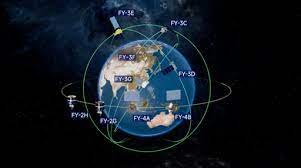By Li Hongmei, People’s Daily
China’s Fengyun meteorological satellites, among the diverse man-made satellites orbiting the Earth, monitor meteorological conditions on the planet at all times, making important contributions to global disaster prevention and mitigation efforts, climate change response, as well as sustainable economic and social development.
Fengyun satellites are a series of remote-sensing meteorological satellites independently developed by China. Since the successful launch of the country’s first meteorological satellite in 1988, Fengyun satellites today are widely applied in such fields as weather forecasting, climate prediction, natural disaster and environmental monitoring, and scientific research.
China has by far successfully sent 21 Fengyun meteorological satellites of two generations into space. Currently, nine of them are operating in orbits, providing data and products for 129 countries and regions around the world.
With multiple satellites in orbit conducting networked observations, Fengyun meteorological satellites are able to provide three-dimensional (3D), quantitative, global, all-day, all-weather, hyperspectral, and timely precision monitoring data.
The extraordinary capabilities of the Fengyun satellites enable precise monitoring of all types of weather and climate events. It has detected all typhoons, performed 3D “computed tomography (CT) scans” of rainstorms, accumulated the dataset of climate variables for El Nino, and carried out more tasks.
The satellites have provided remarkable service support for the construction of the Belt and Road Initiative (BRI) and become the backbone of the global Earth observation network.
In recent years, data obtained from the instruments on the Fengyun meteorological satellites have been playing an increasingly important role in data assimilation of the numerical weather prediction models of the European Centre for Medium-Range Weather Forecasts (ECMWF), said Niels Bormann, a Principal Scientist in ECMWF Research Department.
Integration of satellite-based Earth observation data and ground-based observation data allows for better monitoring of meteorological disasters and their impacts on agriculture.
In the past few years, Fengyun meteorological satellites have been used to monitor extreme drought events in Central Asia, facilitate studies of drought mechanisms, climate change and its impacts, identify affected areas, and then help these areas reduce adverse impacts and enhance climate resilience, according to Sanjarbek Muratov, the Food and Agriculture Organization of the United Nations (FAO) representative to Uzbekistan.
On November 13 last year, the China Meteorological Administration (CMA) launched the international version of FengYun Earth, a comprehensive application platform serving services by leveraging the Fengyun meteorological satellites and satellite remote sensing technology.
The international version of the platform, specially developed for international users, boasts outstanding capabilities. It can effectively obtain multi-source data such as meteorological satellite data and numerical weather prediction data, while identifying disastrous weather and extreme climate events with the help of artificial intelligence (AI) technologies.
It also provides users with more than 100 quantitative and multi-scale products in five categories for different business scenarios, covering cloud charts, key elements, disaster events, climate, and model verification. According to different countries and regions, it can be configured to focus on certain meteorological factors, observation areas, and time ranges, among other aspects, so as to meet users’ personalized needs.
Shortly after its debut, the international version of FengYun Earth received an order – to provide support for the 17th Pacific Games hosted by the Solomon Islands.
At the invitation of the meteorological bureau of the Solomon Islands, the CMA sent experts to the Solomon Islands, while starting the fast-scan mode of the Fengyun-4B (FY-4B) satellite for meteorological observations centered on the Solomon Islands. Leveraging the platform, the CMA provided dozens of satellite products for the Solomon Islands, delivering strong support for the successful holding of the 17th Pacific Games.
In an effort to better serve international users, the CMA established an emergency support mechanism regarding disaster prevention and mitigation of Fengyun satellites in April 2018. A total of 34 countries had registered for the mechanism by 2023.
Since the beginning of 2023, Fengyun satellites have responded 28 times to global requests for emergency support services.
They have observed tropical cyclones Lola and Mocha, providing meteorological support to countries including the Solomon Islands, Vanuatu, and Bangladesh. They have also helped monitor concentrated ignition points of devastating forest fires from the northern coast of Algeria to northwest Tunisia, offering important assistance for the fire prevention and control efforts of local authorities.
According to CMA statistics, over the past five years, more than 1,000 international users have been trained for better use of Fengyun meteorological satellite-based products. The CMA has provided support concerning application software for Fengyun satellites’ remote sensing services and held video consultations on relevant services and products for over 20 countries and regions across the world more than 50 times.






